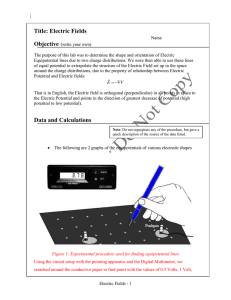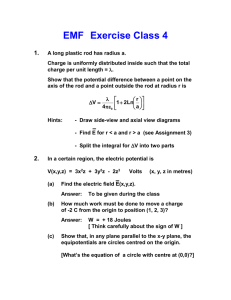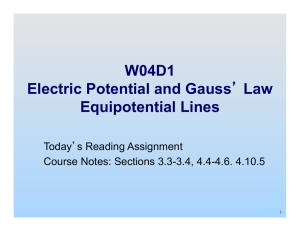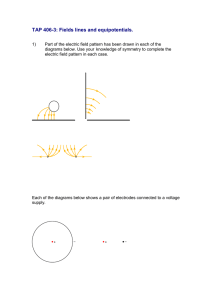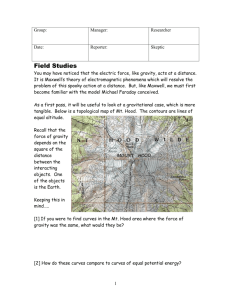Point Charges and Equipotential Surfaces
advertisement
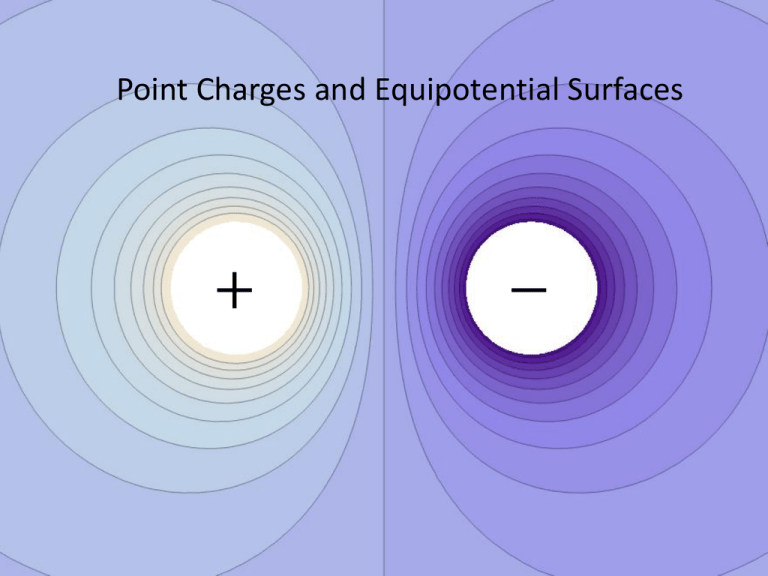
Point Charges and Equipotential Surfaces + − Equipotentials in Other Fields On the map below, the low temperatures for the day have been plotted over the United States. The people who made the map connected all of the weather stations that reported the same temperature, hence the lines on the map represent paths of equal temperature. Topography adds a third dimension to the flatmap picture of the world. Sometimes elevations are indicated with different colors or by number labels 2 Equipotentials in Electrostatics (Optional Derivation) 𝑊 = 𝐹𝑒 ∆𝑟 cos 𝜃 = 𝑞 𝐸 ∆𝑟 cos 𝜃 ∆𝐸𝑃𝐸 = −𝑊 = −𝑞 𝐸 ∆𝑟 cos 𝜃 = 𝑞∆𝑉 ∆𝑉 = − 𝐸 ∆𝑟 cos 𝜃 ∆𝑉 ⇒ = 𝐸 cos 𝜃 ∆𝑟 ∆𝑉 𝜃=0⇒ = 𝐸 ∆𝑟 max Main poin: Electric field lines can be obtained by finding the direction in which change of potential is maximum 3 Equipotentials in Electrostatics ∆𝑉 ∆𝑟 = 𝐸 max • Equipotentials are virtual lines (or surfaces in 3D) along which the potential does not change. • Electric field lines point perpendicular to equipotentials • Electric field points from higher 𝑉 toward lower 𝑉. • If equipotentials are drawn so that ∆𝑉 is const. then 𝐸 is higher in places where equipotentials are closer together. Simulation: http://www.falstad.com/vector2de/ 4 Equipotentials of Objects • For a point charge the equipotentials are concentric circles in 2D and spheres in 3D. • Equipotentials of a sphere are also spheres • Does it mean the equipotentials of a rod are boxes? Why? 5 Energy and Equipotentials • How much work is needed to move a charge along an equipotential line between points 𝐴 and 𝐵? 𝑊 = −∆𝐸𝑃𝐸 = −𝑞∆𝑉 • Between any points on an equipotential line the potential is the same by definition: 𝑉𝐴 = 𝑉𝐵 ⇒ ∆𝑉𝐴𝐵 = 𝑉𝐴 − 𝑉𝐵 = 0 ⇒ ∆𝐸𝑃𝐸 = 0 ⇒ 𝑊 = 0 Simulation: http://phet.colorado.edu/sims/charges-and-fields/charges-and-fields_en.html 6 Equipotentials in Electrostatics Equipotential lines become farther apart away from a charge + − If one charge is much larger than the other + − 7 Consider a charged conductor at equilibrium. What is the electric field and electric potential inside it? A. 𝐸 = 𝑐𝑜𝑛𝑠𝑡 ≠ 0, 𝑉 = 0 B. 𝐸 = 0, 𝑉 = 0 C. 𝐸 = 0, 𝑉 = 𝑐𝑜𝑛𝑠𝑡 ≠ 0 D. 𝐸 = 𝑐𝑜𝑛𝑠𝑡 ≠ 0, 𝑉 = 𝑐𝑜𝑛𝑠𝑡 ≠ 0 8 Electric Potential due to Multiple Point Charges • To find the potential due to several charges at a point 𝑃, just add the potential due to all charges (superposition): 𝑉𝑡𝑜𝑡,𝑃 = 𝑉1,𝑃 + 𝑉2,𝑃 + 𝑉3,𝑃 𝑘𝑞1 𝑘𝑞2 𝑘𝑞3 = + + 𝑟1𝑃 𝑟2𝑃 𝑟3𝑃 • If you have other configurations, for example parallel plates, you add that. For example, a uniform field: 𝑉= 𝐸𝑦 𝑞2 𝑟2 𝑃 𝑟1 𝑟3 𝑞3 𝑞1 +++++++++++ 𝑦 -------------- 9 Electrical Potential Energy of a Point Charge Force 𝐺𝑚1 𝑚2 𝑟2 𝑘𝑞1 𝑞2 𝐹𝑒 = 𝑟2 Gravity 𝐹𝑔 = Electricity Potential Energy 𝐺𝑚1 𝑚2 𝑟 𝑘𝑞1 𝑞2 𝐸𝑃𝐸 = 𝑟 𝐺𝑃𝐸 = − Repulsive (like charges) Attractive Attractive (opposite charges) 10 A charge 𝑞 is at the origin. Consider two points 𝑃1 = (3 m, 4 m) and 𝑃2 −5m, 0m . Let 𝑉1 be the potential at 𝑃1 and 𝑉2 at 𝑃2 . Recall for a point charge 𝑉 = 𝑘𝑞/𝑟. The ratio 𝑉1 /𝑉2 is A. 2 B. 𝑞 C. 1 𝑘𝑞 𝑘𝑞 𝑉1 = = 2 2 5m 3 +4 𝑘𝑞 𝑘𝑞 𝑉2 = = 52 + 0 5m D. −1 11 Demo Problem • A very long negatively charged rod extends along the 𝑦-axis with a field intensity 𝐸𝑟 = 2.0 × 103 N/C. At point 𝑃 = 10.0 cm, 0 there is a positive charge 𝑞 = 1.0 nC. • What is the total electric field at 𝑀 = (5.0 cm, 0)? 𝐸𝑛𝑒𝑡 = 𝐸𝑟 + 𝐸𝑃 𝑘𝑞 9 × 109 10−9 𝑁 3 |𝐸𝑃 | = 2 = = 3.6 × 10 −1 2 𝑟 0.5 × 10 𝐶 𝐸𝑛𝑒𝑡 = 𝐸𝑟 + 𝐸𝑃 = 3.6 × 103 + 2.0 × 103 𝑁 3 = 5.6 × 10 pointing left 𝐶 Point charge: 𝐸 = 𝑘𝑞/𝑟 2 𝑉 = 𝑘𝑞/𝑟 Rod: 𝐸 = 𝑐𝑜𝑛𝑠𝑡. 𝑉 = 𝐸 ∆𝑟 𝐸𝑃𝐸 = 𝑞𝑉 12 Example • A very long negatively charged rod extends along the 𝑦-axis with a field intensity 𝐸𝑟 = 2.0 × 103 N/C. At point 𝑃 = 10.0 cm, 0 there is a positive charge 𝑞 = 1.0 nC. • What is the electric potential difference between 𝑀 = (5.0 cm, 0) and 𝑇 = (7.5 cm, 0) ∆𝑉𝑀𝑇 = 𝑉𝑀 − 𝑉𝑇 ? due to rod: ∆𝑉𝑟,𝑀𝑇 = 2.0 × 103 0.05 − 0.075 = −50 V 𝑘𝑞 𝑘𝑞 due to charge: ∆𝑉𝑃,𝑀𝑇 = − 𝑟𝑀 𝑟𝑇 9 × 109 10−9 9 × 109 10−9 = − = −180 V −2 −2 5.0 × 10 2.5 × 10 ∆𝑉𝑀𝑇 = 𝑉𝑀 − 𝑉𝑇 = ∆𝑉𝑟,𝑀𝑇 + ∆𝑉𝑃,𝑀𝑇 = −230 V Point charge: 𝐸 = 𝑘𝑞/𝑟 2 𝑉 = 𝑘𝑞/𝑟 Rod: 𝐸 = 𝑐𝑜𝑛𝑠𝑡. 𝑉 = 𝐸 ∆𝑟 𝐸𝑃𝐸 = 𝑞𝑉 13

